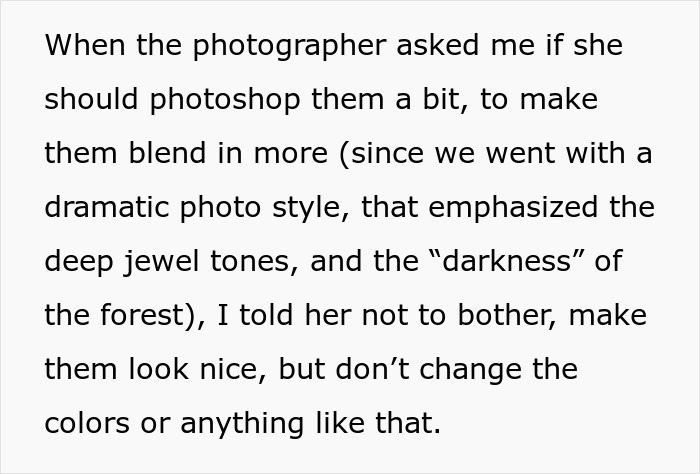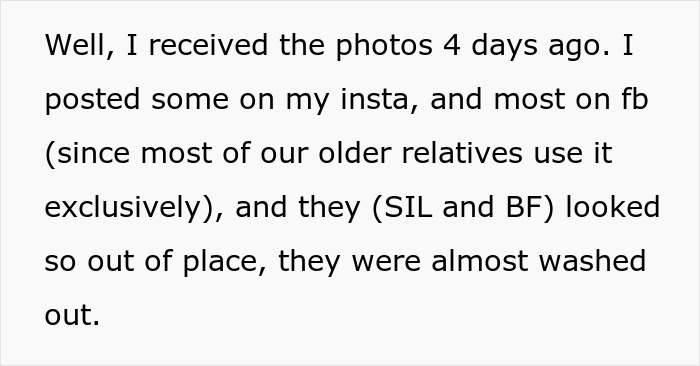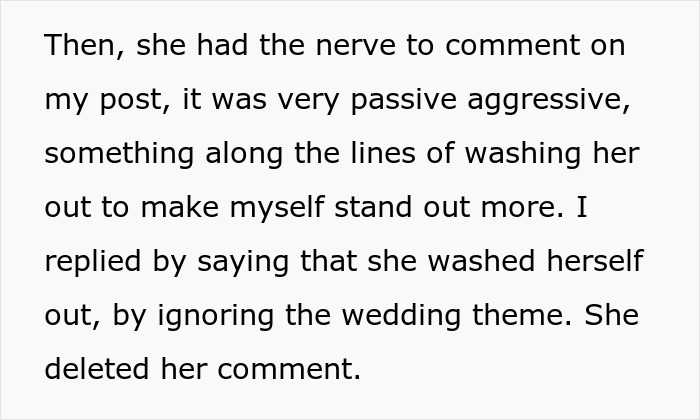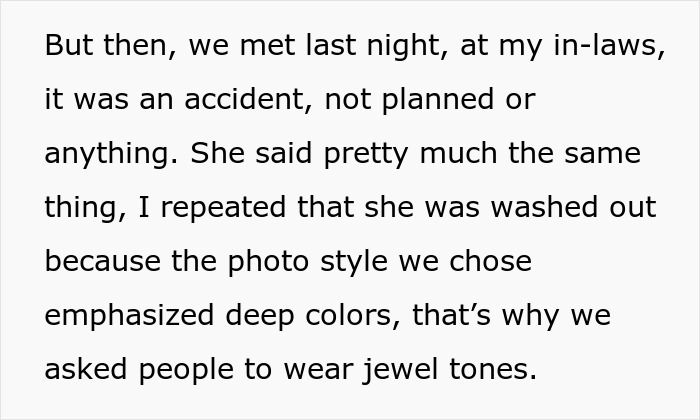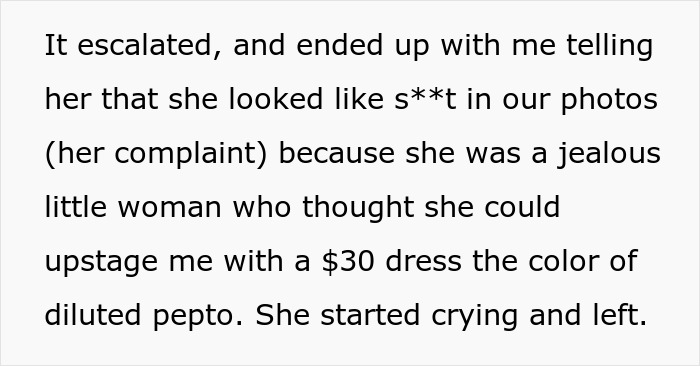Achieving a cohesive theme for a wedding is a challenging task, especially if many people are involved. Chances are, not everyone will be able or willing to stick to “beach formal” or “Western” attire, and some may even have strong opinions about it. But if everyone manages to be on the theme, a guest who doesn’t is bound to stick out, and not in a good way.
Just like what happened to this SIL, who refused to abide by the couple’s ‘faerie court’ vibe of the wedding, characterized by rich, jewel colors. Instead, she showed up in a pale pink dress and her partner in a cream suit. However, their need to stand out majorly backfired when they saw the wedding photos.
Scroll down to find the full story and a conversation with elopement professional specializing in planning and documentation Emma Thurgood and wedding author and former wedding planner of 27 years Jean Neuhart, who kindly agreed to tell us more about wedding dress codes.
Achieving a cohesive wedding theme can pose challenges to couples
Image credits: Jeongim Kwon / unsplash (not the actual photo)
This bride’s SIL showed up completely off the theme, ruining wedding pictures
Image credits: Olga Divnaya / unsplash (not the actual photo)
Image credits: William Bayreuther / unsplash (not the actual photo)
Image credits: Kaitlyn Baker / unsplash (not the actual photo)
Image credits: KnowledgeHefty3256
Sticking to a dress code shows respect and how much the couple means to their guests
“How important is the dress code, anyway?” you must be wondering. Well, according to wedding experts, sticking to it is quite significant if you want to be respectful to the couple. “If a couple has made a dress code request, guests should do their best to honor it,” says elopement professional Emma Thurgood.
“Doing so shows that you are committed to helping them have the wedding that best reflects who they are. Of course, it’s not always feasible for guests to go all out on a themed wardrobe for a wedding they’ve been invited to, but even a small nod in their accessories to the theme shows you care. ”
Meanwhile, wedding author and former wedding planner Jean Neuhart says, “If the couple has requested or indicated a specific dress code for their guests, then it is respectful for the guest to try to adhere to that dress code. A dress code, especially for a themed event, can heighten the enjoyment of the guests and take the guesswork out of “What shall I wear?”
The overall idea of a wedding, especially a themed one, is to look well-dressed and put together without drawing any unnecessary attention. As Neuhart mentioned, dress codes are usually there to guide the guests and help them not get overwhelmed with so many wedding attire options. Indicated colors or styles aid in narrowing down such a wide selection and ensure that everyone will look great together and feel like they are at the right event.
Not following the dress code means that the person will likely stick out of the crowd like a sore thumb
Image credits: Dmitry Zvolskiy / pexels (not the actual photo)
“As far as consequences go, other than irritating the newlyweds on their wedding day (if they even notice that you aren’t in compliance with their dress code), the celebration and enjoyment of the others in attendance won’t really be affected at all,” says Neuhart. “Some people may think, “But they’ll ruin the wedding photos if they aren’t dressed right when everyone else is.” But the reality is, how many wedding photos will they really be in? Also, of any photos that the “incorrectly attired” guest will be in, they won’t be the focal point of the photo anyway. ”
Meanwhile, Thurgood suggests that not following the dress code means the person will likely stick out of the crowd like a sore thumb, drawing more attention to themselves. “There are generally 5 levels of dress—casual, business, semi-formal, formal, and black tie – so it’s best to plan outfits according to the dress code or no more than one level up or down from it.
Guests who are overdressed look like they are trying to steal attention from the couple, while guests who are underdressed are sending a message that they don’t think the wedding is that important to them,” she explains.
Something that can help guests stick to the wedding theme is to eliminate any confusion that might be associated with it. Some guests might not know what “black tie” or “festive attire” means. These terms are also easy to misinterpret, as for some, “business casual” might indicate a pair of jeans and a top, which probably isn’t what the couple has in mind.
Therefore, when making a clothing request for guests, it needs to be extremely clear. If the couple wants to stick to a certain color palette, they should list acceptable colors, and even provide pictures. Writing a ‘cheat sheet’ for invitees explaining the dress code in detail and adding it to invitations can be extra helpful. This way, guests have an even better idea of the direction the celebration is going to take.
However, even going the extra mile might not ensure that the guests show up following the dress code. “Other than putting out gentle reminders of their requested dress code, (on social media, on their wedding website, through word of mouth), or going to the extreme of having a “bouncer” not allow someone entry to the wedding if they aren’t in the correct attire, there isn’t much they can do to make sure their guests follow their dress code,” says Neuhart.
However, all that matters is focusing on what is truly important – celebrating their new marriage with their loved ones, she says. “As long as the happy couple stays focused on what’s really important on the wedding day (their new marriage and the celebration with their loved ones), and chooses not to get upset if a guest shows up wearing non-dress code attire, they’ll feel less stress and more enjoyment on their wedding day.





